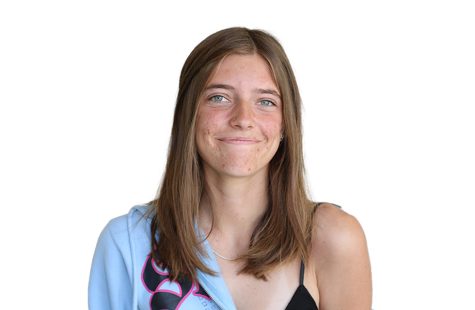
Twitter: @catherine_eik

Twitter username: @LopshireLucy


January 7, 2021
Content Warning: This article discusses mental health disorders and problems with body imaging, topics that some readers may find triggering.
Sophomore Alissa Doe* wakes up to attend her Zoom classes and complete her work. Because of academic pressure, she usually does not have time to eat before class starts. When she does, hours later, she eats more than she normally would, feeling worse than before. This leads to the process of compulsive vomiting, which interrupts her daily routine.
Many other disorders like Doe’s exist among people of all ages and can worsen due to the disordered societal standards.
The result is that many people, especially teenagers, worry about their features.
One of the largest issues among teenagers is dealing with acne, which is a disease of pilosebaceous units (PSUs), according to the U.S. Food and Drug Administration (FDA). There are many forms of acne; the most common ones are pimples, which are also known as pustules, papules, cysts, and nodules. Pustules and papules are usually smaller bumps that appear on someone’s face, while cysts or nodules are more prominent and deeper within the skin. Around 80% of people between the ages of 11 and 30 get acne outbreaks at some point in their lives.
Treatments to deal with these irritations promise fast and achievable results when advertised, but lack said results in reality.
“When I see [acne commercials], it makes me feel like I’m not taking care of my skin, so it makes me think, ‘If I use this treatment, will my skin get better?'” said Nicole Miranda, a sophomore. “Then, when I try [the treatment], it just makes it worse. So it’s just confusing; I want to try it, but can I trust it … will it actually work?”
Miranda has dealt with acne in the past; she noticed that acne treatment commercials create a sense of false hope. Some of the most commonly advertised acne brands include Neutrogena, Curology, and Proactive. These brands push varying treatments; Curology and Proactive have personalized monthly subscriptions that are priced around the same amount. While some people continue to pay for treatments, others listen to influencers such as Skin Care by Hyram, who educates those in need of treatment about what helps their skin.
Even with these resources, teens still have consistent and lasting struggles with acne. Although it is a common issue, acne is still considered to be an unattractive trait.
“The media has definitely blown acne out of proportion,” said Kaitlyn White, a sophomore in Visalia Unified School District. “If you really think about it, step away from all of those negative attitudes towards it … what’s really sad about acne is that it’s natural, especially for all of us in high school to have it. So, it makes me kind of sad because of how negative it is.”
White has managed her acne since it first began in middle school, and her skin has cleared up since then. Having gone through the same struggles as many others, White has advised her peers too.
“Try to get comfortable with yourself and how it [acne] looks; self-gratification is like a wall that no one can smash down,” White said.
Although mental health disorders are a prevalent issue for people of all ages, they are most prominent in the early teen years. According to the National Institutes of Mental Health (NIMH), anxiety is present in about one-quarter of teens. The percentage of anxiety disorders concurring among adolescent females is 38%, and 26.1% in teenage males. Social media platforms like Tik Tok or Instagram often contribute to increasing insecurities that can lead to mental health disorders.
Ida Milani, an intern counselor at Adolescent Counseling Services, has noticed social media as a common trigger among some of her younger patients.
“On Tik Tok, there are a lot of profiles out there that encourage clean eating or healthy eating, but a lot of what they’re preaching is starvation and really disordered eating,” Milani said.
These “healthy eating” videos have led eating disorders to become a more prevalent issue. Bulimia nervosa is an eating disorder that involves recurring episodes of eating irregular amounts of food, followed by forced vomiting, excessive use of laxatives or diuretics, or excessive exercise. Approximately 5% of adolescent and adult women and 1% of men have anorexia nervosa, bulimia nervosa, or a binge eating disorder. Doe, who is diagnosed with bulimia, shared their struggles with the condition.
“It gives me lots of stress because if I eat anything, I get this feeling that almost sends me into an anxiety attack,” Doe said. “Most of the time, while I’m doing my schoolwork, I need to stop what I’m doing to go purge [forced vomiting].”
Doe is one example of the many teenagers who struggle with different types of mental disorders and eating disorders. Mental health disorders are affected by society’s distorted beauty standards, but body imaging also plays into the distortion.
The expected body standards for society shifts over time, making it hard for people to keep up. It also can depend on location, as different countries and communities have different expectations.
For example, ancient Egypt expected a slim figure, a high waist, long braided wigs, and black eyeliner, which varied from places like Britain, where most had tousled hair, an asymmetric face, and an hourglass figure. Another example of differing beauty standards was in the 1920s, when women cut their hair into a bob and had a masculine silhouette. However, the body standard in the ’50s changed to possessing flawless skin and a curvy shape. Different eras possessing different beauty standards show that expectations continue to change, indicating no one achievable or perfect body.
“Society is always going to have a different body for us every five years … Building awareness about what can build your self-image, your confidence, and your resiliency will keep you away from having to stray towards those,” Milani said.
Society’s pressures call for men, women, and children to look a specific way. According to Dr. Jake Linardon, almost 15% of Australian men reported having an overvaluation of weight and shape. 9% of U.S. adult men said they frequently check their bodies, with 5% reporting body image avoidance. In a French university, more than 85% of the students reported dissatisfaction with their muscularity. 70% of women in a Switzerland study expressed the desire to be thinner, despite 73% of the women falling into the normal weight range.
Along with men and women, research has shown that around 50% of 13-year-old American girls reported being unhappy with their bodies, growing to 80% by the time they turn 17. 80% of young teenage girls also said that they fear becoming fat. With many girls wanting to fit the ideal body type, companies and society push the idea of weight loss and workouts.
“The perfect body is unreachable, so companies can keep on pushing products and give you this goal of how you should look that you’ll never be able to reach,” Doe said.
The constant fear of body image and how others perceive it is hard to grow out of, and many people struggle with it for most of their lives.
Social media creates a breeding ground for insecurities. Although social media can have its perks, it quickly brings people down because of how others display their lives.
“The public view, you don’t see what’s going on behind social media or behind what they said. You’ll hear some of it, see some of it,” Miranda said.
As a society, people only see a small portion of others’ lives, which causes constant comparison and false expectations due to that portion being perfected for public view and most often unrealistic. According to a study done by Clarissa Silva, 60% of people that use social media have reported their self-esteem levels have been impacted negatively.
With constant comparison, the process of posting is a mentally exhausting one, especially among teens.
“When I post something on Instagram, I’ll just have to have that mentality; ‘Okay, I like this photo, and I’m posting for myself. I can do this; I can do this.’ And I’ll just click the button with my eyes closed because you never want to visualize the bad things people can say to you,” White said. “You’re creating that negativity in your mind because people aren’t even saying anything yet, but you can make up things about yourself because people have commented that in the past.”
The thoughts that continue to run through one’s head when sharing things on social media can take over in all aspects of their life. Although social media can induce negativity and self-consciousness, it is essential to develop confidence first and remember that what matters is the personal view.
“I used to look in the mirror and cry because I hated what I looked like. Over quarantine, I was able to really focus on myself. And even though it took five months, I’m able to just see myself in the mirror and be like, ‘You know what? I deserve to be happy,’ it’s something that people shouldn’t expect to happen overnight,” White said.
*This name has been changed to protect the anonymity of the source, in accordance with Carlmont Media’s anonymous sourcing policy.

